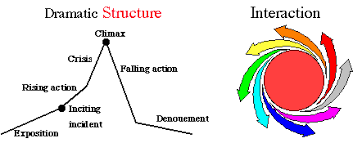The dramatic elements are at the core of all drama. They can be used in isolation or
simultaneously and are manipulated by the performer for dramatic effect.

1. Focus
Focus is often used as the terms concentration and engagement, assisting the
performer in the portrayal of believable characters. Furthermore, focus requires the channelling (focusing) of all the performer’s energies into achieving the given goals or objectives of a character in a scene .
2. Tension
Tension can lies in the development of suspense in a performance. As the audience anticipates certain outcomes in the plot, the tension builds. tension usually parallels the advancement of the plot, leading to a crisis or climax. Tension is closely linked with timing.
3. Timing
Timing in performance refers to dramatic timing of movements and gestures. When performing, the use of our body must be carefully considered. Rhythm and pace are affected by timing.
4. Rhythm
Rhythm refers to the timing and pace of the drama. It also means the beat or tempo of the performance. As a rule, rhythm should never be the same throughout the drama, regardless of its length. Rhythm can follow the emotional state of one or more characters or the atmosphere of the performance at particular moments.
5. Contrast
Without the careful use of contrast a performance is boring and lacks tension. An obvious example of contrast is a sad scene followed by a happy one.
6. Mood
Mood is the feeling or tone of a performance. It created through a combination of several dramatic and stagecraft elements working in harmony with each other. The mood of a performance is closely linked with everyday feelings such as pity, anger, desire or frustration. Mood in drama can be created via sound, lighting, movement, setting, rhythm, contrast, conflict and more.
7. Space
This dramatic element refers to the effective use of available space in a performance such as sitting, bending over, lying down or crawling. In order to use the space effectively, movement becomes an important factor.
8. Language
The use of language in performance can be verbal, vocal or non-verbal. Language is the spoken text. While normally spoken by the actor, language can also be chanted or sung. The choice of language in performance is crucial.. Exactly how the actor in performance uses language is usually determined by the expressive skill of voice. However, language can also be non-verbal, commonly referred to as body language.
9. Sound
Modern theatrical practice relies on sound to assist in a number of ways. It can be useful in creating atmosphere or mood. Actors and their bodies can construct effective sound in performance.
10. Symbol
The use of symbol in dramatic performance can be one of the simplest and also most complicated of all techniques. Symbols can also be found in the use of colour. We often symbolise purple with royalty, red with anger or desire, black with evil and darkness or white with purity and innocence. Colour association can be worthwhile symbols with costumes, sets and props. But the most sophisticated use of symbol occurs with the application of gesture and movement. A gesture can also be a powerful symbol.
11. Conflict
Drama that lacks conflict is normally dull and uninspiring. As a rule, conflict should always be considered an essential ingredient for all dramatic performances. Conflict can be between two or more characters, or simply one (inner conflict). Conflict on stage can be verbal, physical or non-verbal (psychological). Conflict differs from tension in that it is often a fixed part of the structure of a play, with characters destined to clash with one another from the outset.

12. Climax
Most drama will have one or more crises in the development of the plot. A crisis is a key moment of dramatic tension and conflict in the play, usually occurring between two or more characters and having serious implications for the outcome of the plot. The ultimate crisis, or highest peak, is usually called the climax occurs toward the end of a performance. There can also be more than one climax, although this is uncommon.
- See more at: http://www.thedramateacher.com/dramatic-elements/#sthash.2tYMlXvM.dpuf

















Oh thanks. Just refreshed my memory
ReplyDeletethank u
ReplyDelete